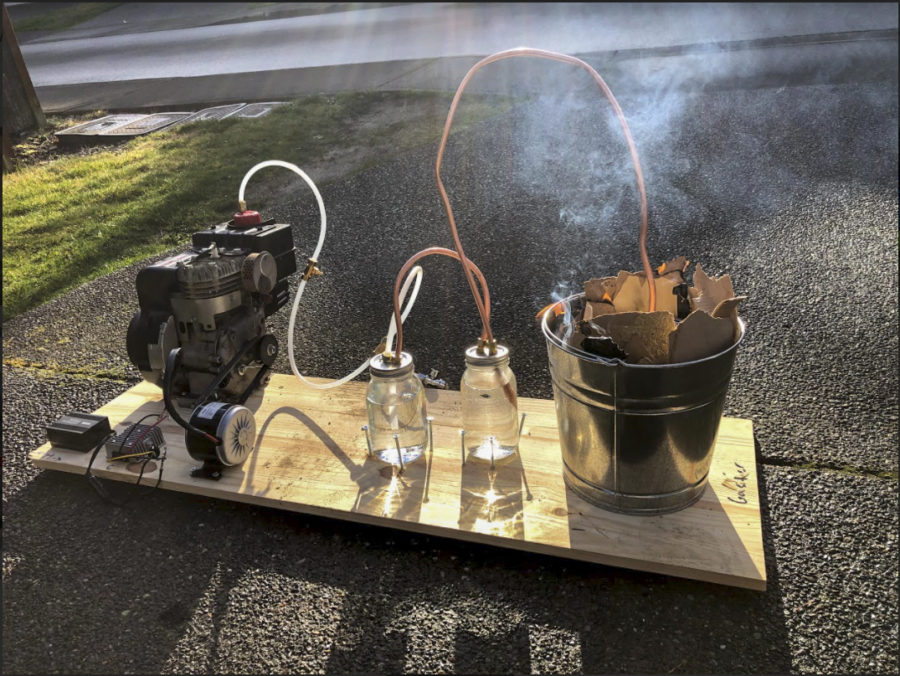Students design system to create electricity in Nigeria
Students focused on Nigeria because some of them are from the country; hope to expand to other developing countries
To create electricity, the students built a system that burns waste and collects gas to convert to energy in the jars.
April 15, 2021
WSU students are designing a portable gasifier system to turn waste into electricity in Nigerian households.
The systems are currently used in industrial plants in developed countries, said Corey Ndifon, WSU engineering senior and CEO of the team. They power big cities, but the idea of the project is to make the system available on a smaller scale for individual households in Nigeria and then, hopefully, other developing countries.
Gasification is a process that uses an engine to convert solid waste, garbage and trash into gases like nitrogen and oxygen that can be used for energy, said Philip Virtue, WSU engineering senior and chief technology officer of the team.
In order for the gasification system to work, the waste must be completely dry and not contain metals or mercury, Virtue said. The waste is then burned in an enclosed container.
The temperature inside the container must be at least 700 degrees Celsius, said Maximillian Obasiolu, WSU engineering senior and chief business development officer of the team.
The molecules must be heated at higher temperatures in order to break apart and release gases and energy, Ndifon said. Gasification burns everything in a furnace, and it is possible that some of the toxic gases can be released.
Deadly toxins, such as methane and carbon dioxide, are filtered out using filtering systems, Virtue said.
The team plans to create a design using solar panels as an alternative source to start the gasifier, and the risk of toxic gases being released into the atmosphere will be minimal with a filtration system that will be inserted in the entrance and exit of the device, Ndifon said.
Once the waste is converted to gas in the gasifier, it can be used as energy, he said.
Twenty pounds of trash can produce approximately 10 kilowatt-hours of energy per day, about one-third of the energy used daily in a typical home in America, Virtue said.
Without electricity, certain groups are at a disadvantage, Ndifon said. They have trouble producing agriculture, are not as connected to the rest of the world and websites, like Amazon, are not accessible.
“The end goal is to help the more rural regions of Nigeria, and other emerging nations, have stable electricity,” Ndifon said.
He said he came up with the idea for the project because he realized people could use the surplus of waste in Nigeria to create a much-needed energy source.
Both Ndifon and Obasiolu said they are from Nigeria and designed the system with Nigeria in mind after they met in an engineering course.
The work and market research for designing a portable gasification system began in August 2020, Ndifon said.
The COVID-19 pandemic caused a setback because the Frank Innovation Zone on the WSU campus was forced to close, he said. The FIZ had the 3D printers, metal and wood workrooms needed to create the system. The group was instead forced to build the system in a garage, taking more time.
“We weren’t as well equipped as the FIZ,” Ndifon said. “It took longer and was more tedious.”
The gasification system will solve multiple problems, Virtue said. It will address waste management and lack of electricity in rural areas.
The gasifier system is not ready for the market yet. It will take a significant amount of funding to finish, Ndifon said.
He said the group received $5,000 from the Alaska Airlines Environmental Innovation Challenge at the University of Washington. They are planning on entering more competitions to raise money for the project.
Right now, they are revising their project design, Ndifon said. The group received feedback from the EIC competition and is fixing flaws in their original plan.
They were originally going to use a large turbine engine to run the system, but the complexity of the engine and possible complications were pointed out by the judges, Ndifon said. The system will instead have a smaller four-stroke engine, so the system is less complicated.
“Since we’re going to be essentially shipping a device to a foreign country, we want to make sure that if and when the device breaks, repairs on it are going to be as simple as possible,” Obasiolu said.
With a four-stroke engine, the device will be able to run for extended periods of time, but people can repair it more easily, Ndifon said.
Once the project is complete, the group plans to sell their gasifier to international nongovernmental organizations, specifically the United Nations Development Program because it has connections with commerce and transportation and will be able to disperse the system, he said.
Roughly $100,000 is still needed to design, build and transport the product by the end of 2021, Ndifon said.
“As far as technology goes, we can’t really do much more until we get more funding,” he said. “So we are really focused on the business side of [the project right now].”

















